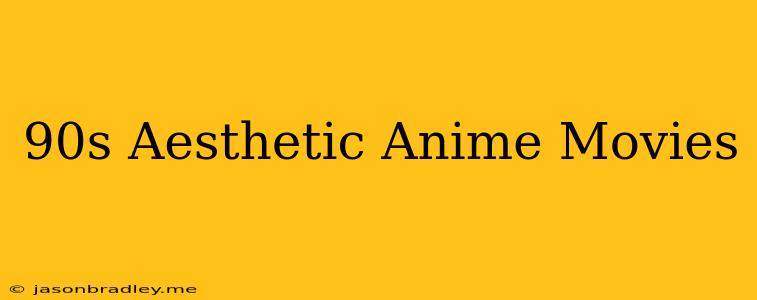A Blast from the Past: Exploring the 90s Aesthetic in Anime Movies
The 90s was a golden age for anime, a time of vibrant experimentation and stylistic exploration that left an indelible mark on the medium. While many anime films from this era explored themes of mecha, fantasy, and coming-of-age, a distinct aesthetic emerged, showcasing a unique blend of retrofuturism, bold color palettes, and intricate details.
Here's a look at some of the key elements that define the 90s anime aesthetic and examples of movies that embodied them:
The Allure of Retrofuturism
One of the most prominent characteristics of the 90s anime aesthetic is its embrace of retrofuturism. This subgenre of science fiction, popular in the 1950s and 60s, imagines a future where technology is advanced but still retains a distinct vintage feel.
Examples:
- Ghost in the Shell (1995): This cyberpunk masterpiece, set in a futuristic world where technology and humanity blend seamlessly, utilizes a visually striking blend of retrofuturism and cyberpunk elements. From the sleek, futuristic cityscapes to the iconic cyborg protagonist, Major Motoko Kusanagi, the film's visuals are a testament to the era's fascination with the intersection of technology and humanity.
- Akira (1988): This landmark anime film, set in Neo-Tokyo, is a prime example of retrofuturism in action. The futuristic cityscape, with its towering skyscrapers and intricate details, embodies a unique blend of retro and futuristic aesthetics, creating a world both familiar and alien.
A Symphony of Colors
The 90s saw a resurgence of vibrant color palettes in anime, often embracing bold hues and striking contrasts.
Examples:
- Princess Mononoke (1997): Studio Ghibli's masterpiece, features a breathtaking palette of emerald greens, fiery oranges, and earthy browns, reflecting the film's themes of nature and conflict.
- Neon Genesis Evangelion (1995): This iconic anime series and its subsequent films, while often dark and melancholic, employ a vibrant color palette, with bold reds and blues reflecting the intense emotions and internal struggles of the characters.
Intricate Details and Artistic Flourish
Beyond the bold colors and retrofuturistic settings, 90s anime films also featured intricate details and artistic flourishes that brought their worlds to life.
Examples:
- Paprika (2006): This mind-bending psychological thriller, set in a world where dreams and reality blur, features intricate details in its animation, particularly in the dreamscapes, which are both beautiful and unsettling.
- Perfect Blue (1997): This psychological thriller, which explores the blurring lines between reality and illusion, features masterful animation, particularly in its portrayal of the protagonist's psychological descent.
Beyond the Visuals: Storytelling and Themes
The 90s anime aesthetic wasn't just about visual style. Many films from this era explored complex themes of identity, morality, and the human condition, often set against the backdrop of futuristic landscapes or intricate fantasy worlds.
Examples:
- Nausicaä of the Valley of the Wind (1984): This early masterpiece by Hayao Miyazaki explores themes of environmentalism and the delicate balance between humanity and nature.
- The Vision of Escaflowne (1996): This mecha anime explores themes of love, loss, and the burden of responsibility, set against a backdrop of fantasy and adventure.
The 90s aesthetic in anime continues to inspire contemporary filmmakers and animators. It is a testament to the enduring power of visual storytelling, blending artistic ingenuity with thought-provoking narratives. So, the next time you find yourself drawn to a futuristic world, a vibrant color palette, or a story about the human condition, consider revisiting these iconic anime movies. You might be surprised at how much they resonate with you, even decades later.
